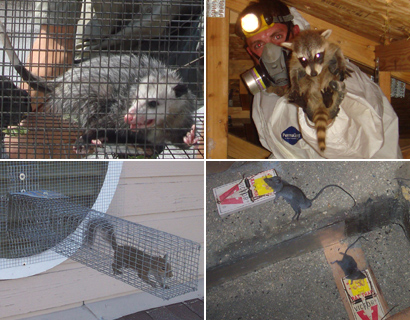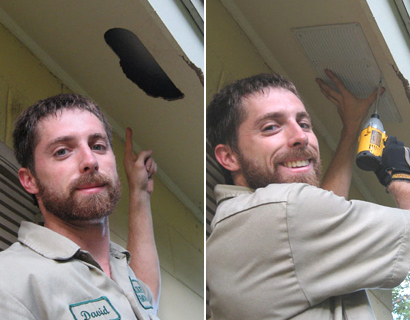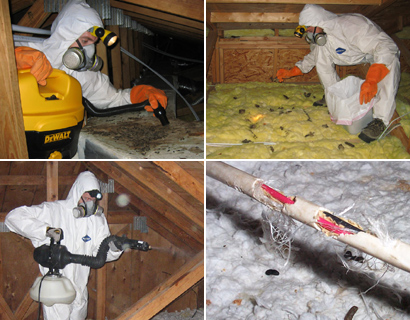- How We Solve North Carolina Wildlife Problems
How We Solve Raleigh Wildlife Problems
INSPECTION: Once on site, we will perform a full inspection of your home and property. This allows us to use the correct strategy and traps. If the animals are in an attic, a full building inspection is crucial, including the following:
- All ground-level areas, such as piper or A/C line entry & exit areas, A/C chase bottoms, ground-level vents, etc.
- All mid-level areas, such as dryer vents, siding gaps, first floor eaves or dormers, etc.
- We inspect the entire roof, including all plumbing stacks, ridge caps, vents, and other potential gaps or holes.
- We also inspect inside your attic, to identify animals and damage they have caused.
- If the animals are outside, we notice many subtle clues that will assist us in a successful strategy.
TRAPPING, EXCLUSION, REMOVAL: Once we understand what animal species we are dealing with, and the problem, we use the most effective means of removing the animals. We use dozens of different types of traps.
- Trapping - If trapping the animal(s) in live cage traps, trap type, set, and location are crucial to success.
- Exclusion - Oftentimes, we are able to simply set one-way doors or other exclusion devices that allow the animals inside a building to safely exit, but never get back inside.
- Removal By Hand - Sometimes we actually remove animals by hand, or with special tools like snare poles.
- The Law - In all cases, we obey state and local laws regarding wildlife, but aim to take the most humane approach.
ENTRY HOLE REPAIRS: Repairs are a crucial step in the wildlife removal process. In many cases, such as bat or rodent control, the job cannot be performed without detailed repairs, and in all cases, sealing the entry holes shut ensures that no future wildlife will ever enter your home.
- 100% of the entry holes must be found, and sealed shut, or the job is not complete.
- Our repairs are professional contractor grade, look good, and when applicable we use steel, which rodents such as rats or squirrels are unable to chew through.
- We give a written guarantee on our repairs against any future animal entry.
ATTIC DECONTAMINATION SERVICES: It may be desirable to clean your attic after we've removed the animals. They can leave behind large amounts of droppings, urine, hair, oils, food, nesting material, and so on. These remnants can attract insects like cockroaches, and the scent left behind can encourage new animals to chew their way into your house. You might experience odor problems from the waste. It's possible that mold will grow on waste areas.
- We remove or vacuum all droppings, or remove all the soiled insulation.
- We fog the attic with a special enzyme-based cleaner that destroys any organic matter and deodorizes the space.
- We repair damage, such as ductwork, electrical wires, pipes, insulation, and more.
North Carolina's wildlife critters are beautiful, when they aren't trying to live in your home! Critters, such as squirrels, can find their way into your attic by looking for/creating holes for them to come and go as they please. You may not even know they are up there, or maybe you've been hearing some unexplained noises. Regardless we answer our phones 24 hours a day, 7 days a week to answer all of your questions and take care of your wildlife removal and trapping needs! We serivce the following cities: Oak Grove, Apex, Bethseda, Blands, Ganlee, Morrisville, Knightdale, Lizard Lick, Shotwell, Rolesville, Forresrville, New Light, Hopkins, Archer Lodge, Clayton, Auburn, Cary, Wake Forest, Millbrook, and Durham. We also service the following counties: Mitchell County, Martin County, Mecklenburg County, Clay County, Cleveland County, Columbus County, Tyrrell County, Union County, Vance County, Wilkes County, Wilson County, Yadkin County, and Yancey County.
Other Raleigh animal pest control topics:
Should I Keep a Squirrel as a Pet
What to do About Raccoons Under Your Porch
What is a Black Racer Snake
Best Bait to Trap a Mouse
To learn more about our services, visit the Raleigh wildlife control home page.
This month's wildlife how-to article: The Brown Water Snake
The Brown Water Snake
Appearance
Brown water snakes are rather large. They come in at 30 to 60 inches! They are semi-aquatic snakes and they are rather heavy. They mostly come in some sort of brownish shade, ranging from light to dark brown with big, dark brown square patterns. These patterns usually run down the snakes center in a line and on the sides of the body in alternating rows. Their underside is usually a lighter shade of brown but this too has the distinctive square pattern as well as black cresecents. Unlike other water snakes, the brown water snake has a narrow head with the eyes higher up on the head and close to the tip of the nose. Female brown water snakes are much larger their male counterparts.
Biology
As was mentioned before, brown water snakes (Nerodia Taxispilota) are semi-aquatic and such, have been given several names including:
• Water pilot
• Great water snake
• Water rattle
• Southern water snake
They are usually mistaken for Cottonmouths but unlike them, brown water snakes are not poisonous.
Life Cycle
Brown water snakes have been reported to live up to and around six years. It is during the spring - April to May - that they mate. Their maiting takes place in the safety of tree branches but will also do so on land. Sometime during the late summer, a female will then finally give birth to somewhere around 20 to 60 young, live snakes. This is because the eggs hatch inside the mother. Young brown water snakes are usually much longer and bigger than female brown water snakes when they are born - somewhere around 7 to 10 inches in length. They will then start to grow very quickly during the first three years.
Habitat
As their name suggest, the brown water snake, live in water such as large streams and rivers.
In the US, they are often found in the states of:
• California
• Southern Virigina
• Florida
They can also be found in the coastal areas of Georgina, Ontario, Canada.
They prefer flowing waters like:
• Canals
Diet
Probably obvious enough but brown water snakes love eating fish.
But they also will consume other animals as well, such as:
• Frogs
• Earthworms
• Rodents
Behavior
Brown-water-snakes are equally as active during the day as they are at night. They are often found spread out on tree branches near flowing water. This is somewhat of a leisurely past time for them when they aren't busy hunting. Their location is also a strategic one: should they encounter a predator, they can easily dive into the safety of the waters below and flee from danger. Despite not being poisonous, they do deal out a rather nasty bite if they feel threatened.





